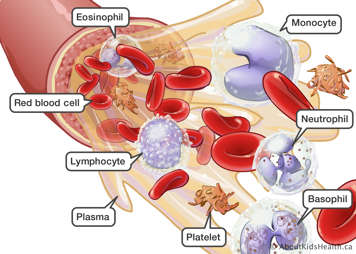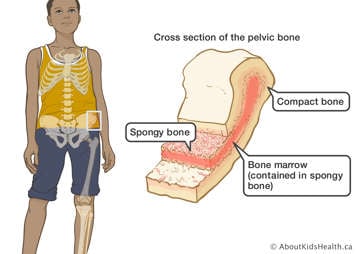Our blood, marrow, and the lymphatic system are closely linked and constantly working together to fuel our bodies.
Blood
Blood carries the oxygen we breathe from our lungs to the parts of the body that need it. It also brings carbon dioxide back from the body to the lungs, so that it can be removed when we exhale. Carbon dioxide is produced when the cells in the body make energy to fuel the body.

Blood is made up of cells that float inside a clear liquid called plasma. The plasma is mainly water. It also contains:
- proteins such as albumin, antibodies (defense proteins), and clotting factors, which help slow down bleeding from a cut or other injury
- hormones, such as thyroid hormones
- minerals such as iron, calcium, magnesium, sodium, and potassium
- vitamins such as folate and vitamin B12
The cells that are suspended in the plasma include:
- red blood cells, which make up 40% to 50% of the blood. They are red because they are filled with a protein called hemoglobin. Oxygen and carbon dioxide attach to hemoglobin. The red blood cells carry oxygen from the lungs to the body and deliver carbon dioxide from the body to the lungs. Red blood cells have a life-span of 120 days. For this reason, the bone marrow continuously makes new red blood cells.
- platelets are small cells that help stop bleeding at sites of the body that are cut or injured. The scab that forms over a small cut is made possible thanks to platelets. The bone marrow continuously makes new platelets, because they only live for about 10 days inside our blood.
- white blood cells, which fight infection.
There are different types of white cells in the blood, including:
- neutrophils and monocytes, which engulf bacteria or fungi in our body to fight infection
- eosinophils and basophils, which respond to allergic conditions
- lymphocytes, which are also found in the lymph nodes, spleen, and lymphatic channels
There are three major types of lymphocytes, which are a key part of the immune system. These include:
- B-lymphocytes, which originate in the bone marrow, produce antibodies to fight off infection. The antibody attaches to the microbe, tagging it as "foreign". Infection-fighting cells called neutrophils can now recognize the microbe, engulf and digest it.
- T-lymphocytes, which originate in the thymus, help B-lymphocytes make antibodies against invading bacteria, viruses, or other microbes.
- Natural killer (NK) cells are lymphocytes that directly attack virus-infected cells.
The life-span of white blood cells is also limited, and our bone marrow continuously makes new white blood cells.
Bone marrow
Blood cells are made inside the spongy tissue in our bones, called bone marrow. The process of blood cell formation is called haematopoiesis. Blood cells start off as stem cells, which are young cells that grow into mature blood cells. Healthy people have enough stem cells to keep on producing new blood cells, continuously.
Blood flows through the marrow to pick up fully formed platelets, red cells and white cells to circulate to the rest of the body.

The lymphatic system
The blood-cell-forming system in our marrow is closely linked to our lymphatic system. The lymphatic system consists of the bone marrow, the spleen, and in young people, the thymus. It also consists of lymph nodes, which are scattered throughout the body. The lymphocytes travel between each node through the lymphatic channels, which meet at large ducts that empty into a blood vessel. The lymphocytes enter the blood through these ducts.
